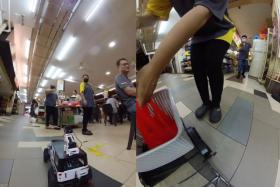Flying-Cam helicopters go from Hollywood to reconnaissance missions
Since its founding in 1988, unmanned helicopter manufacturer Flying-Cam has been involved in the shooting of about 500 feature films - including the Harry Potter and James Bond series - in more than 75 countries.
In 1995, the Belgian company won an Oscar for technical achievement, for pioneering the development of mounting a motion-picture camera on a remotely-operated miniature helicopter.
The demands of the movie industry, however, have propelled the company in recent years to venture into the defence sector, with its single-rotor helicopters used for surveillance and reconnaissance, as well as detecting sea mines.
Founder and chief executive Emmanuel Previnaire, 63, said: "The movie industry, while niche, is very demanding, asking for high-quality imagery in all kinds of environments.
"This led us to acquire a lot of know-how, like being able to deploy our helicopters out of a speedboat."
MODELS UNVEILED
Two such models were unveiled during the company's debut at the 12th International Maritime Defence Exhibition and Conference (Imdex) Asia, a biennial show that opened at Changi Exhibition Centre on Tuesday.
The smaller helicopter is about 2.16m long and can cruise at 20m per second while the other is about 3m long with a cruise speed of about 25m per second.
They can be configured to carry different payloads and sensors, like high resolution cameras, useful for surveillance to see if the crew of a ship are armed, for instance.
Yesterday, Singapore's navy gave the media a tour of its unmanned surface vessels (USV) that can detect and deactivate sea mines.
A USV, with two operators controlling it remotely, takes about six minutes to deploy sonar equipment to detect the mine. Currently, the Bedok-class Mine Countermeasure Vessel (MCMV), operated by a crew of about 30 men, takes about 45 minutes to do it.
Get The New Paper on your phone with the free TNP app. Download from the Apple App Store or Google Play Store now


